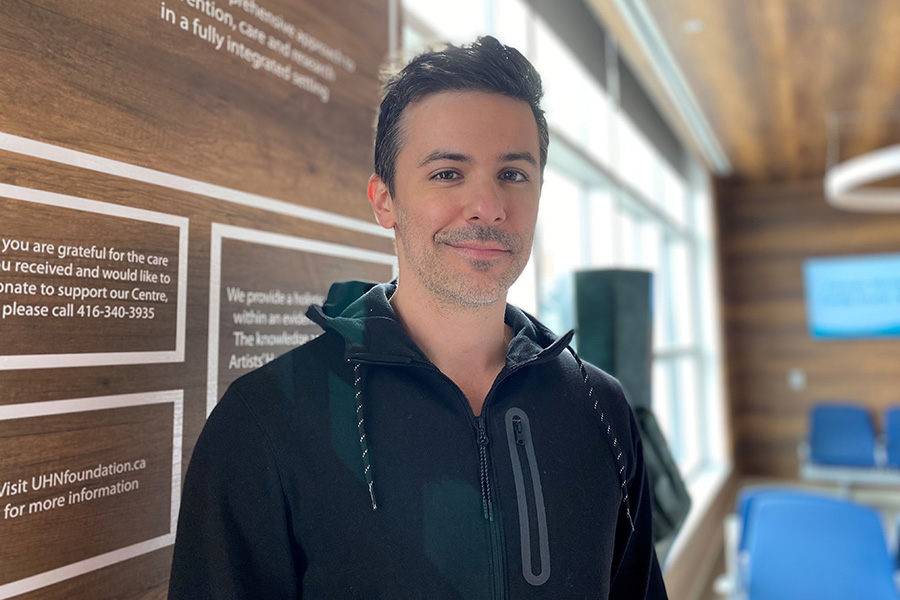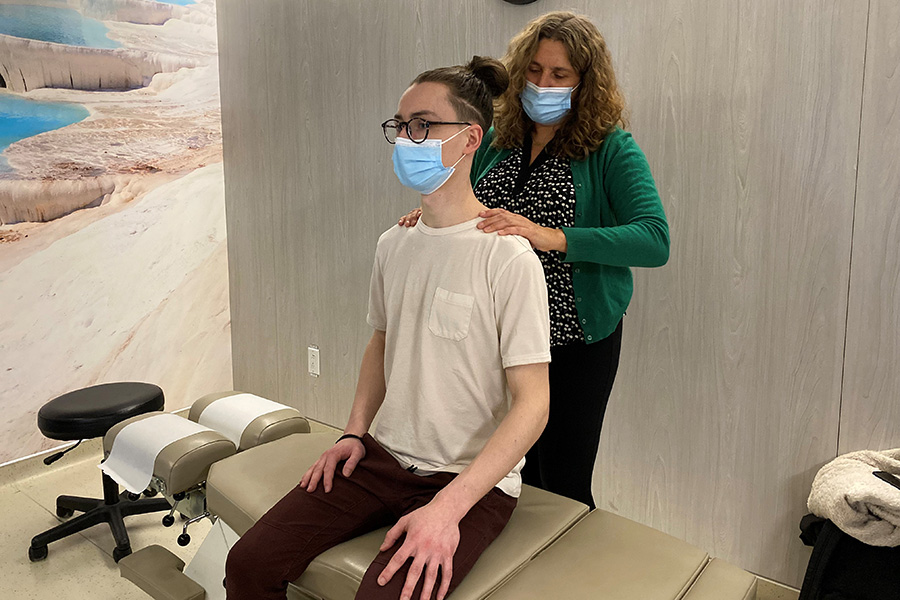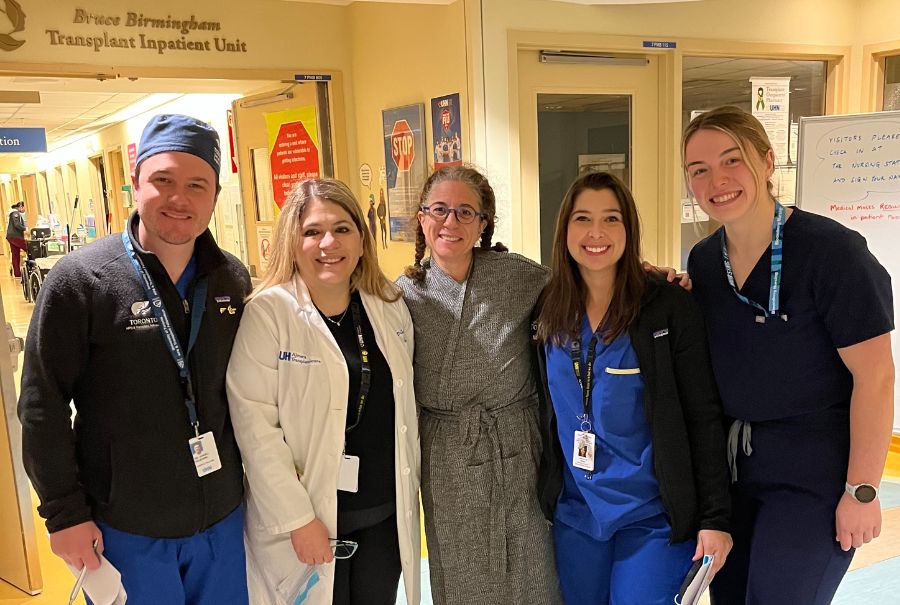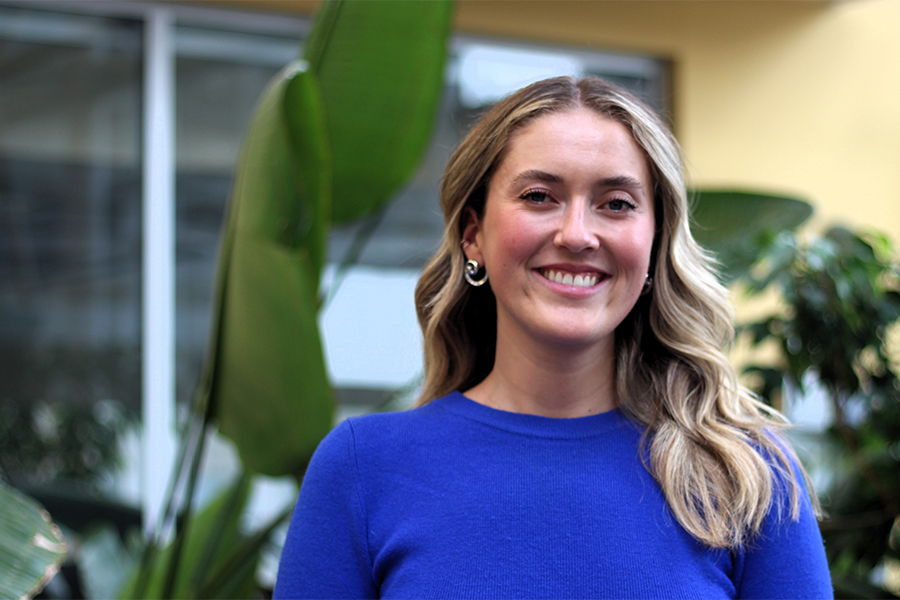David Liam Roberts, a Toronto cellist, started coming to the Al & Malka Green Artists’ Health Centre at Toronto Western Hospital when he needed care resulting from the repetitive movements of playing an instrument. (Photo: UHN)
Being an artist doesn’t come without its challenges.
Dancers and musicians can develop repetitive injuries. Actors might become anxious from past and future performances. Artists who work with materials such as clay or ceramics may face lung complications.
Fortunately, UHN’s Al & Malka Green Artists’ Health Centre specializes in treating artists and the complications that arise from their professions. Their health care team treats patients who are artists of all disciplines, and each service is tailored to meet the unique needs of their artistry.
One of these patients is David Liam Roberts, a cellist freelancing in Toronto and studying at the Glenn Gould School of the Royal Conservatory of Music. He started scheduling regular appointments at the Artists’ Health Centre when he needed care associated with playing his cello.
“A lot of people might be surprised about the strain that playing an instrument puts on your body,” says David Liam, who works with health care specialists such as chiropractors and massage therapists to help address risks resulting from his occupational duties.
“In some ways, being a musician is like being an athlete,” he says. “We engage in repetitive physical motions on a daily basis, so it’s really important that we are doing them sustainably.”
David Liam plays the cello four hours a day, seven days a week. He began coming to the centre when he started experiencing pain in his spine due to the repetitive motions resulting from playing.
“It helps to have a physiotherapist see how you play the instrument and critique any repetitive motions you make that might be a risk for developing an injury overtime,” he says.
Between his travels across Eastern Canada performing as a cellist, David Liam sees the centre’s massage therapist every month or two to ensure his muscles including upper body, shoulders and back are in working order. He also has bimonthly visits with the centre’s physiotherapist to focus on daily exercises that prevent injury to strengthen muscle groups.

The Al & Malka Green Artists’ Health Centre is a unique clinic and the first of its kind in Canada that provides care to all artists regardless of individual discipline. It’s also one of very few clinics in the city that integrates complementary therapies into traditional medical settings and care models.
“Whenever we watch a film, listen to music, or come across a beautiful sculpture in a foreign city, we owe it to the artists who created them,” says Dr. Shelly-Anne Li, Head of Research and Quality Improvement at the Artists’ Health Centre.
“In return, we must recognize the value of their contributions and take care of their health.”
Many artists are self-employed or have unstable incomes, making it difficult for them to access health care. By offering cost-friendly, artist-centered health care services, the centre can help ensure that artists receive the care they need to stay healthy and continue creating.
Since opening in 2002, the centre has treated about 500 Ontario artists annually. It offers a host of artist-centered services, including psychotherapy, physiotherapy, registered massage therapy, chiropractic services, acupuncture, and more. Recently, virtual wellness workshops have been made freely available to artists across Canada.
“Having health care providers that understand the burdens of being a musician and the strain placed on the body is extremely beneficial for musicians when it comes to pursuing long-term careers,” says Dr. Li. “The same applies to dancers, singers, sculptors and many more artists who are going through repetitive strain or mental health challenges.”
Offering services to a niche group of Torontonians
Toronto is known for its diverse patient population with many in the city identifying as artists. Many of them not only experience unique physical challenges, but also emotional challenges that can limit their ability to pursue their passions.
Ian Rayburn, a Toronto filmmaker, sought mental health service support from the centre while navigating the business of independent film production.
“It’s niche to artists, and that’s what brought me there,” says Ian.
“Being an independent filmmaker is hard, there’s a lot of pressure we put on ourselves,” he says. “I work from home and there’s often no set schedule.
“These factors can really impact myself and a lot of other people in similar situations.”

Ian says that being able to speak to someone who caters to his identity as an artist helps him to feel more confident in pursuing his work.
“Being able to talk to someone who understands my unique challenges as an artist has really helped me continue to pursue my passion.”
Another perk of the clinic is that it is subsidized based on financial income and occupational limitations.
This benefit was particularly helpful for Ashley Proctor, who encountered a life-changing accident when she was riding her bicycle to school one morning.
“I went from being at the top of my class to not being able to complete my program,” says Ashley, a multidisciplinary artist who was a student at Ontario College of Art and Design (OCAD) at the time, and is now a curator, who owns a consulting business serving the creative and co-working industries.
Addressing issues ‘that came as a result of my profession’
In the critical first months of treatment, the Artist’ Health Centre helped to subsidize Ashley’s care, as it does with all artists who demonstrate financial and health need. If a patient qualifies, they can apply for the Joysanne Sidimus Fund, which subsidizes 75 per cent of all their treatment costs at the centre, up to $760 per year. Artists who are eligible can apply each year, for two consecutive years.
This subsidy also proved useful to Laura Bil, a freelance artist and art instructor at Sheridan College whose class was cut during the COVID-19 pandemic.
“I was suddenly facing a career change,” she says. “That was an entire stream of income that had been cut just like that.”
Laura’s role as a college instructor resulted in long periods of time sitting at a computer, which in turn resulted in enhanced physical distress.
“The Artists Health Centre’s subsidy allowed me to receive chiropractic and physiotherapy services that had been associated with my physical pain,” she says.
“With their support, I was able address the issues that came as a result of my profession.”


